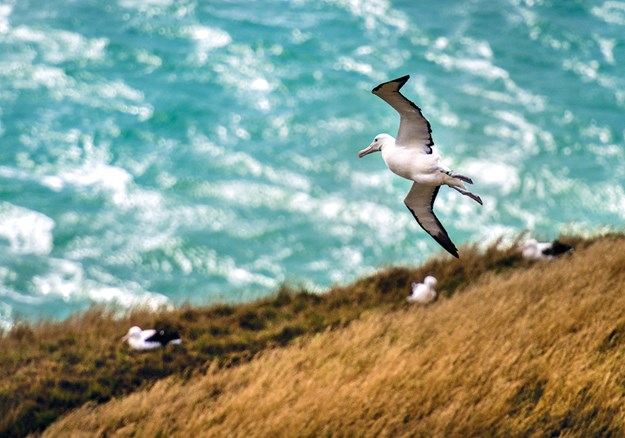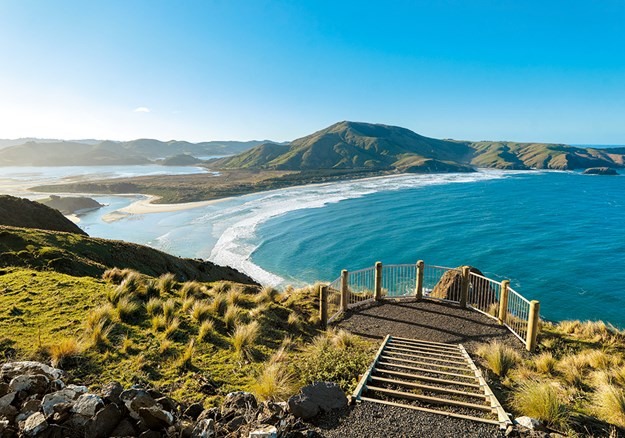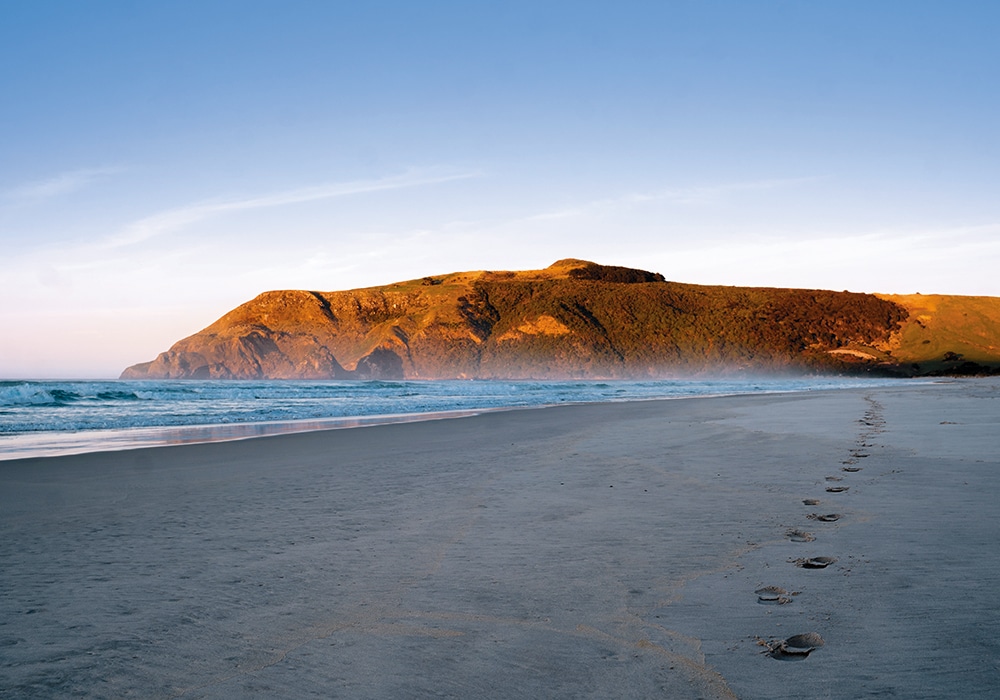4pm: Meet my guide at Dunedin i-SITE
When I met Lyndon, ranger to the world’s only mainland royal albatross colony for 30 years, he seemed as excited as I was. Despite giving up his job as head ranger, he was still thrilled to take visitors to see Dunedin’s wildlife as a tour guide, he said. That’s why he started Horizon Tours, a family business dedicated to helping people explore the city’s wild side. And that’s why he was chuffed to show me and two others, Si and Holly, his newly launched wilderness and wildlife tour.
 |
|
A sea lion on Allan’s Beach
|
As we climbed into Lyndon’s mini van on a grey Saturday afternoon, he reckoned we’d see everything from ancient remnant forest to wetland, and from wading birds to sea lions, fur seals and penguins. If we were really lucky – and the wind was just right – we might even glimpse the majestic royal albatross in flight. Hearing the likely line-up, I was keen to hit the road.
4.30pm: See ancient forest and wetland birds at Ross Creek Reservoir
It was a cool 10 degrees when we entered Woodhaugh Gardens en route to the Ross Creek Reservoir. Walking the easy, flat track, Lyndon told us we were now within the town belt in one of the city’s oldest parks (dating back to the 1890s). He liked to bring people here to show off the wildlife living so close to the city, as well as Dunedin’s remnant forest. On our bush walk, we saw kereru flapping above metres-high kahikatea. We identified the main tree species iwi would have used to make fire in centuries past: mahoe and kanuka. And we soaked up entomology factoids such as: most New Zealand trees are pollinated by moths, not birds. Then we wandered past the exception to the rule: the kotukutuku, the world’s largest tree fuchsia, under which lay a thick carpet of its own dainty flowers.
 |
|
A majestic royal albatross
|
At the Ross Creek Reservoir, the country’s oldest still in use, Lyndon recognised a loud, discordant krark coming from across the lake. So we each grabbed a set of binoculars and trained them hopefully on bobbing shapes in the water.
Bingo: three Australian coots (owners of the krark noise), a couple of diving ducks called scaup and several tawny welcome swallows.
 |
|
Allan’s Beach – wild but beautiful
|
6.50pm: Drive around Hooper’s Inlet to spot wading birds
Birdwatching was still our primary goal at Hooper’s Inlet on the Otago Peninsula. But this time we looked for waders. In the van, Lyndon dished out snacks of chocolate and biscuits, telling us Dunedin’s birdlife had always fascinated him.
Growing up on the peninsula, he’d become obsessed with oystercatchers. Aged seven, he declared he would become a wildlife officer, without really knowing what the job entailed. Yet it was no surprise to his school careers advisor when he left school aged 17 to join DOC, eventually working as head ranger at Taiaroa’s royal albatross colony.
As we pulled up to Hooper’s Inlet, we felt confident the sandy bay would deliver. Sure enough, we saw a family of pukeko mucking about in roadside reeds. On mudflats, spoonbill with jagged white head feathers and long black bills fed on crabs. With plenty of finger-pointing from Lyndon, we spied bar-tailed godwits, pied stilts and spurwing plover.
 |
|
A royal albatross and chick
|
7.30pm: Search for rare sea lions at Allan’s Beach
At Allan’s Beach we were on the lookout for New Zealand sea lions – one of the world’s rarest sea lion species. Lyndon warned us to keep 10 metres away from any sleeping sea lions, and 20 metres back from sea lions and seals protecting their pups. As the sea lion population has declined to 12,000, they are now considered a ‘nationally vulnerable’ species, Lyndon told us. Maybe it was no surprise that despite scouring the soft white sand for the fawn-coloured sea mammal, we came away with no sightings.
 |
|
Ross Creek
|
8.30pm: Stop at Taiaroa Head to see royal albatross
Located on the wind-thrashed tip of the Otago Peninsula is Taiaroa Head. For years it was Lyndon’s stomping ground.
Tonight, as we pulled up to our final stop, the clifftop was home to thousands of nesting seabirds like the red-billed gull and Taiaroa’s less rowdy resident, the royal albatross. After a hasty fill of hot soup, we pulled on Horizon Tours’ padded coats and headed to the windy viewing platform. From there we watched royal albatross take to the sky to test their enormous wings against the breeze. In slow succession, they glided over the headland out to sea and back to land. By 9pm, it was time to stop gawping at the graceful birds and join the tourist throng in the visitor centre.
See Dunedin’s wildlife with Lyndon Perriman this winter Horizon Tours’ wildlife and wilderness tours run year-round. In winter, they start earlier in the day to make the most of the daylight. To check times or to book a tour with Lyndon, visit horizontours.co.nz
 |
|
Little blue penguins
|
9.30pm: Watch little blue penguins at Pilot’s Beach
The sky was turning pink when it came time to wrap up the indoor presentation and head down the hill to wait for little blue penguins at Pilot’s Beach. Lyndon assured us the little blues would come ashore only when it was dark. We needed to quieten down on the viewing platform and turn off our camera flashes. Ignoring Lyndon’s first suggestion, three sea lions loudly harrumphed on the beach below, while half a dozen seals honked as they settled in for the night. Within 20 minutes Lyndon could see a ripple out to sea. It was the first group, he promised. They were on their way. Cameras ready, we watched the ripple get closer and closer to the beach until a breaking wave propelled a dozen tiny penguins onto land. Over and over it happened until more than a hundred of the precious blue seabirds had safely waddled up the beach and into their grassy burrows for the night.
Help protect Dunedin’s extraordinary wildlife
Dunedin’s wildlife is worth protecting. Here’s what we can do to play our part:
- Keep dogs away – they can harm species and stop them breeding.
- Keep a safe distance. Sea lions are endangered and can bite. Penguins are rare too, and get easily stressed – stay clear of their nests and don’t use flash photography near them.
- Don’t feed the wildlife – human food can kill red-billed gulls.
- Know when to use drones. They are prohibited in many sensitive areas such as Taiaroa Head.
- Give generously to Dunedin’s wildlife charities, such as its Wildlife Hospital. Find out more at dunedinnz.com/wildlifecharities






